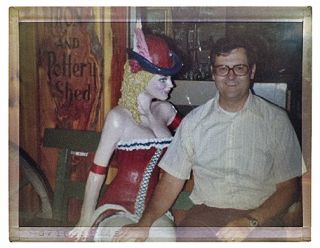
Reighner Deleighnie and the love of her life
In March 2012, a number of national British newspapers reported the story of , a 40-year old woman from London who claimed that she had fallen in love with a three-foot statue of the Greek God Adonis that she bought for £395. It was reported that:
“She enjoys reading and talking to her companion, and keeps him close by when she watches television and eats dinner. She also kisses and caresses him, imagining the pair of them walking through meadows of wildflowers or at the seaside. She shares the condition with Amanda Whittaker, a 27-year-old shop assistant from Leeds who has fallen head over heels for the Statue of Liberty.”
Agalmatophilia is a sexual paraphilia in which individuals derive sexual arousal from an attraction to (usually nude) statues, dolls, mannequins and/or other similar body shaped objects. It is also part of a wider condition known as ‘object sexuality’ (i.e., those individuals who develop deep emotional and/or romantic attachments to specific inanimate objects or structures) that I wrote about in a previous blog. The behaviour can manifest itself in many forms including actual sexual contact with the body-shaped objects, fantasies of having sexual encounters with the body-shaped objects, the act or sexual fantasy of watching encounters between the body-shaped objects themselves, and/or sexual arousal from thoughts of being transformed or transforming into a body-shaped object. (Because of this latter variation, some commentators have noted there are elements of transformation fetishism). It has also been claimed that for some agalmatophiles, the idea of immobility or loss of control can be arousing. For other agalmatophiles, there may also be fantasies about paralysis that may cross over into hypno-fetishism and/or robot fetishism.
Agalmatophilia can also include 'Pygmalionism' that is usually defined as a state of love for an object of one’s own creation. Pygmalion was a Greek sculptor and misogynist who fell in love with a statue he had carved. In Greek mythology (and according to Ovid), after seeing the Propoetides prostituting themselves, Pygmalion lost all sexual interest in women. The legend has it that his carved statue was so realistic that he fell in love with it. He prayed to Aphrodite (the Greek godess of love) to bring the statue to life. Aphrodite eventually granted his wish and Pygmalion married the once statue. (I feel duty bound to point out that this view is not universal. A 1978 paper in the Journal of the History of the Behavioral Sciences by two New Zealand historians, Dr. A. Scobie and Dr. J. Taylor, state that Pygmalionism is not—and shouldn’t be confused as—a form of agalmatophilia).

Most of the academic writings on agalmatophilia are either case studies and/or historical writings (which are hard to confirm). For instance, Dr. Brenda Love in a 2005 book chapter on “Cat-fighting, eye-licking, head-sitting and statue-screwing” said that Clisyphus allegedly “violated the statue of a goddess in the Temple of Samos, after having placed a piece of meat on a certain part”. Dr. Love also reported that having sex with statues was commonplace among worshippers of Priapus where virgins were first penetrated by him. (For those who don’t know, Priapus was a fertility god, and protector of fruit, gardens, livestock, and male genitalia. All illustrations of Priapus accentuate his oversized, permanent erection that has given rise to the painful medical condition ‘priapism’ in which the penis remains erect for long periods). Even in the 20th century, Dr. Love reports that young Indian female virgins have been documented as making love to statues as a way to break their hymens.
Arguably the first academically documented case was by Richard Von Krafft-Ebbing in his 1877 text Psychopathia Sexualis. Here, Krafft-Ebbing recounted that case of a male gardener who fell in love with a statue of the Venus de Milo and was discovered attempting to have sexual intercourse with it. In a 1978 issue of the Journal of Sex Research, Murray White, a psychologist based in New Zealand, examined the clinical and literary citations relating to agalmatophilia. Although making reference to case studies outlined by Krafft-Ebbing and Havelock Ellis, he found found only one “single documented instance where this condition existed as part of a complex manifestation of symptoms but a number of instances where it occurred as a pornographic fantasy.” Despite the rarity of the condition, White did at least conform that the condition was a bona fide clinical entity.
More recently, Dr. Brenda Love in her 2005 book chapter outlined two more case studies (one of which I think was originally in Robert Tralin’s 1969 book The Sexual Fetish). The first case was the case a 34-year old man who at the age of 12 years became obsessed with a life size museum statue. He subsequently bought two small statues he spotted in a shop window and began regularly masturbating with them. At the time of the report being written, he had been masturbating with the aid of the statues for 22 years and was still doing it even though he was now happily married.
The second case involved a window dresser who developed overwhelming urges to masturbate every time he saw a naked mannequin. This appeared to be related to his first sexual experience when he was forced to perform fellatio on a man while sitting on mannequins. As time went on, he also developed desires to rub up against mannequins and also liked other men to watch him do it.

There are also cases of what could perhaps be described as ‘pseudo-agalmatophilia’. For instance, Dr. Brenda Love noted that in the sado-masochistic community, some masochists are ordered by their sexually sadistic partners to become a statue and not move while being fondled. There is nothing in the empirical academic literature outside of case studies although one website essay on agalmatophilia claims men who participate in these fetishes outnumber women 10 to 1, but that there are many women who participate as well. It also states that:
The sexual stimulation results more from a need of control and sexual gratification without emotion from either counterpart. It can be easily misunderstood as a shallow, cruel, and heartless depiction of sexual stimulation, and although this may be true for some, it is not true for all. Some use this as a way of performing derogatory acts without actually harming anyone…Agalmatophilia is a difficult concept to comprehend, especially when considering the mental states behind these fantasies. However, one should always consider whether the actions harm real individuals or not. In some cases, this is just a derogatory fantasy. For others, this is just sexual gratification that stems from loneliness or the lack of confidence in an ability to find a partner.
In the absence of any empirical sources to back this up, it is hard to assess the validity of these claims, but the claims seem plausible. As with most rare paraphilic behaviours, we have no way of knowing whether the published case studies are in any way representative of all people who have such sexual interests.
References
Krafft-Ebing, R. (1977). Psychopathia Sexualis. New York: Paperback Library (1965 reprint).
Love, B. (2001). Encyclopedia of Unusual Sex Practices. London: Greenwich Editions.
Love, B. (2005). Cat-fighting, eye-licking, head-sitting and statue-screwing. In R. Kick (Ed.), Everything You Know About Sex is Wrong (pp.122-129). New York: The Disinformation Company.
Scobie, A. & Taylor, J. (1975). Perversions ancient and modern. Agalmatophilia, the statue syndrome. Journal of the History of the Behavioral Sciences, 11, 49-54.
Tralins, R. (1969). The Sexual Fetish: Case Histories of Bizarre Sexual Hangups. New York: Paperback Library Books.
White, M.J. (1978). The Statue Syndrome: Perversion? Fantasy? Anecdote? Journal of Sex Research, 14, 246-249.




